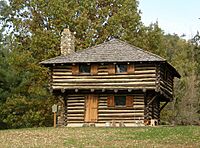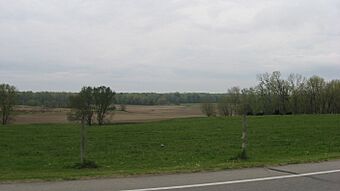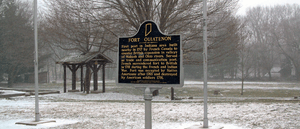Fort Ouiatenon facts for kids
Quick facts for kids Fort Ouiatenon |
|
|---|---|
| West Lafayette, Indiana | |

The replica of the blockhouse
|
|
| Type | Fort |
| Site information | |
| Controlled by | New France; Great Britain; First Nations |
| Site history | |
| Built | 1717 |
| In use | 1717–1763 |
| Garrison information | |
| Past commanders |
François-Marie Bissot(Fr); Edward Jenkins(Br) |
|
Fort Ouiatenon Archeological District
|
|

Fields at the site
|
|
| Lua error in Module:Location_map at line 420: attempt to index field 'wikibase' (a nil value). | |
| Nearest city | Lafayette, Indiana |
| Area | 17.5 acres (7.1 ha) |
| Built | 1717 |
| NRHP reference No. | 70000008, 100006239 |
| Significant dates | |
| Added to NRHP | February 16, 1970 |
| Designated NHLD | January 13, 2021 |
Fort Ouiatenon was the very first European settlement in what is now Indiana, United States. It was built in 1717 by the French. The fort was a strong wooden fence, called a palisade, with a log building inside, called a blockhouse. It served as a French trading post along the Wabash River. The fort was about three miles southwest of where West Lafayette is today.
The name 'Ouiatenon' comes from the French way of saying a word in the Wea language. That word, waayaahtanonki, means 'place of the whirlpool'. Fort Ouiatenon was one of three French forts built in the 1700s in the area then known as New France. This area later became the Northwest Territory and is now the state of Indiana. The other two forts were Fort Miami and Fort Vincennes.
A large French community grew around Fort Ouiatenon in the mid-1700s. After the French and Indian War, the fort was given to the British and then left empty. Later, Native American tribes took control of it. In 1791, American soldiers destroyed the fort during the Northwest Indian War. It was never used as a U.S. fort.
The original site of the fort was found again in the 1960s. This important historical site was added to the National Register of Historic Places in 1970. It was also named a National Historic Landmark in 2021.
Today, a replica of the fort stands a short distance from the original site. Every year, usually in late September or October, a special event called the Feast of the Hunters' Moon is held there. It's a fun way to experience what pioneer life was like.
Contents
French Control: Building a Trading Post
Fort Ouiatenon was first built by the government of New France. It was a military outpost meant to protect against Great Britain expanding its lands to the west. The fort's location in the wild forests of the Wabash River valley also made it a key place for the fur trade.
French traders and trappers from Quebec came to Fort Ouiatenon. They were looking for beaver furs and wanted to trade with the local Wea Native American tribes.
Early Days of the Fort
In 1717, a French officer named Ensign François Picote de Beletre arrived. He came with four soldiers, three other men, a blacksmith, and supplies. Their goal was to trade with the nearby Wea people. The Wea were an Algonquian-speaking nation, closely related to the Miami people.
They built a strong wooden fence, or stockade, on the Wabash River. It was about eighteen miles downriver from where the Tippecanoe River joins the Wabash. Later, in the 1720s, François-Marie Bissot, the Sieur de Vincennes took command of the fort. The French settlers lived on the north side of the river, while Wea villages were on the south side.
A Busy Trading Center
To encourage the Wea to trade only with the French, the Governor-General of New France, Philippe de Rigaud Vaudreuil, gave special permission for trade at Ouiatenon. Soon, traders brought a steady stream of goods to the new settlement. Officials from Louisiana also sent more men to help Vincennes control the Wabash River area.
Fort Ouiatenon was known as "the finest palisaded fort in the upper country." It became one of the most successful trading posts in the entire region. At its busiest time in the mid-1700s, Fort Ouiatenon may have had over 3,000 people living nearby. It was the center of five Wea villages and two Kickapoo villages.
British Control: After the French and Indian War
In September 1760, New France was given to the British. After this, a British officer named Robert Rogers sent soldiers to take over Ouiatenon. A group of British soldiers, led by Lieutenant Edward Jenkins, arrived in 1761 and took control of the fort.
Pontiac's War and the Fort's Capture
On June 1, 1763, during a conflict known as Pontiac's War, the Wea, Kickapoo, and Mascouten peoples captured Ouiatenon. They surprised Lieutenant Jenkins and his men, taking Fort Ouiatenon without a fight. Seven other similar British forts were also captured during this widespread Native American uprising.
The British did not use Fort Ouiatenon much after the French and Indian War. They never kept soldiers there again. In the mid-1770s, the fort was described as being 70 yards from the Wabash River.
At that time, a description noted: "The Ouiatenon nation of Indians is on the opposite side, & the Kiccaposses are round the Fort, in both villages about 1000 men able to bear arms." Even as late as 1778, Ouiatenon was a place where war parties gathered to fight for the British government.
Native American Control and Destruction
In 1778, Captain Leonard Helm and Lt. Bailey arrived to claim the fort for the American rebels. A British agent named Celeron, who controlled the fort, tried to leave but was captured with 40 men. By December of that year, a British company arrived and raised the "St. George's Ensign" flag in the fort. Soon after the Americans captured Vincennes in 1779, Captain I. Shelby came to Ouiatenon. He received promises of help from the Wea people.
However, during the 1780s, local Native American tribes used the fort as a base. From here, they resisted the westward movement of white American settlers. Because of this, President George Washington ordered the fort to be destroyed in 1791.
The Blackberry Campaign
In an operation called the "Blackberry Campaign," Northwest Territory Governor Arthur St. Clair ordered General Charles Scott to attack villages along the Wabash River. Fort Ouiatenon was the main target.
In May 1791, Scott crossed the Ohio River and marched to the Ouiatenon area with 750 Kentucky soldiers. While Colonel John Hardin led a group to the Big Pine Creek to destroy a large Kickapoo village, Scott led the main force to Ouiatenon. The Native Americans present left the area. Colonel James Wilkinson led a group of mounted soldiers down to the river to fire on those trying to escape.
Ouiatenon was then burned to the ground. The soldiers also destroyed several other nearby villages. This included the large village of Keth-tio-e-ca-muck, near the mouth of the Tippecanoe River. During this attack, 38 Native Americans lost their lives, and 58 were taken prisoner, mostly women and children. The Kentucky soldiers had no men killed and only five wounded.
After this, Ouiatenon was never again an important historical site.
Fort Ouiatenon in the 20th Century
The remains of the old fort were lost over time, and the land became a farm in the 1900s.
Rediscovery and Preservation
The exact location of Fort Ouiatenon was found and confirmed by archaeologists in the late 1960s. The Ouiatenon Preserve is located about a mile west of the Fort Ouiatenon Historical Park. It is along South River Road and the Wabash River. This preserve includes the site of the original 1700s Fort Ouiatenon and nearly 200 acres of land around it. In 1970, the U.S. Department of the Interior added the site to the National Register of Historic Places.
The Replica Fort Today
In 1930, a local doctor named Richard Wetherill built a replica of Fort Ouiatenon. Since there were not many good records of the original fort, this replica is mostly based on imagination. The Daughters of the American Revolution had placed a small marker near this spot in 1909.
Dr. Wetherill's blockhouse was actually designed like British forts, using horizontal logs. This is different from the original Fort Ouiatenon, which used vertical logs. Today, this replica blockhouse is the main feature of Fort Ouiatenon Historical Park. The Fort Ouiatenon Blockhouse Museum is open to visitors in the summer. It is also the location of the yearly Feast of the Hunters' Moon. Many rare items from the original Fort Ouiatenon are shown by the Tippecanoe County Historical Association during the Feast.
See also


